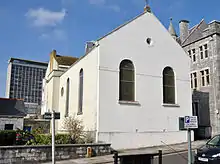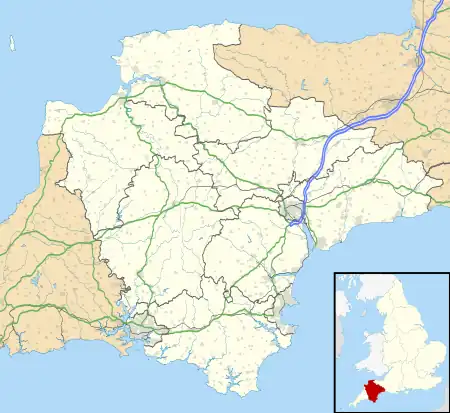| Plymouth Synagogue | |
|---|---|
 The synagogue | |
| Religion | |
| Affiliation | Orthodox Judaism |
| Region | Devon |
| Location | |
| Location | Plymouth, England |
 Location within Devon and the United Kingdom | |
| Geographic coordinates | 50°22′10″N 4°08′27″W / 50.369366°N 4.140816°W |
The Plymouth Synagogue is a synagogue in the city of Plymouth, England and the home of the Plymouth Hebrew Congregation.[1] Built in 1762, it is a listed Grade II* building[2] and the oldest extant synagogue built by Ashkenazi Jews in the English speaking world.[1][3][4][5][6]
History
A Jewish community was present in Plymouth by the mid-18th century. The members were immigrants, primarily from the German lands and the Netherlands. Most were members of an extended family with the surname Emden.[4]
They are known to have been meeting regularly for services in private homes by 1745, at some point the services moved to rented rooms. Plans for building a synagogue had begun by 1759. In 1762 building land was leased, but the lease was signed by a Christian named Samuel Champion since it was not clear that leases signed by Jews were legal. The Congregation bought the freehold in 1834.[4][5]
Architecture
No architect's name is recorded, and it is assumed that the rectangular, pitched-roof structure was designed and erected by a local master builder. The building is of whitewashed brick and stone with a roof of Cornish slate. The street front is the eastern end of the synagogue, so the door is placed on the western front, in what is effectively the back garden. The building is tucked on a side-street, Sharman Kadish, the leading expert on Jewish buildings in Britain, believes that an unobtrusive location was chosen to avoid provoking the destructive riots that non-Anglican houses of worship often provoked in the eighteenth century. Nothing on the exterior distinguishes the building from the meeting houses of Nonconformist Protestants.[5]
Kadish believes that the corniced entrance, the date and Psalms 95:6 (O come, let us worship and bow down: let us kneel before the LORD our maker) written in Hebrew dates from the renovation of 1863–1864. The cornerstone of the adjacent three-storey building housing various synagogue offices is dated with the Jewish year 5634 (1874). There is a mikveh in a room off the vestry (hall) and it is open to viewing. It is of white tiling and is no longer in use. The water has been diverted partly due to an irreparable leak and also to logistics. Ref: Anna Kelly Honorary Secretary 2015.
The vestibule is floored with Minton terracotta tile dating from a Victorian era renovation, the present stairs to the women's galleries were built at the same time. The vestibule appears to be a Victorian addition to a prayer hall that was originally entered without a vestibule, the women's galleries probably had external staircases as was once common.[5]
As was usual in British synagogues, there is a prayer board with the Hebrew prayer for the welfare of the British Royal family. The prayer board at Plymouth dates from 1762. It was usual for the name of each new king to be painted over the names of previous monarchs. At present the names being prayed for are listed as George V and Queen Mary (Mary of Teck).[5]
The interior is simple, with the exception of the elaborate Torah ark. The building has a flat ceiling and a women's gallery along three walls. Originally, the women's gallery was confined to the west end. The windows were originally clear glass. The present stained glass was a 20th-century addition. The pair of windows that flank the Torah ark and open onto the street were added in 1874. Kadish believes that putting synagogue windows on a public street may have been judged unwise in the religious climate of the eighteenth century.[5]
Torah Ark
The elaborate, Baroque Torah Ark rises two storeys, the full height of the building. It features fluted Corinthian columns, a broken pediment, carved finials and urns in gold leaf. On the second storey are a pair of tablets of the Ten Commandments, in gold leaf on a royal blue ground. Inscribed on the cornice is the Hebrew date 5522 (1761–62) and a passage form Psalms 5:8 (Lead me, O LORD, in thy righteousness because of mine enemies; make thy way straight before my face).[5]
It is a free-standing piece of cabinet work. It was transported from Holland flat packed and rebuilt when in situ. The Holy Ark however was brought over from the Netherlands in parts and assembled on site – a sort of Georgian flat-pack! A marvellous classical confection of white and gold, it stands in sharp contract to the plain wood of the rest of the building.*Elkan Levy. Kadish believes that it may have been crafted by cabinetmakers in the Netherlands or the German lands. For many years the Ark had "a gentle golden patina." A 2002 restoration has made the Ark bright with gold leaf, white and blue paint.[5]
See also
References
- 1 2 "Plymouth Hebrew Congregation (Plymouth Synagogue)". JCR-UK. 7 May 2017. Retrieved 6 January 2019.
- ↑ Historic England. "Synagogue (1130015)". National Heritage List for England. Retrieved 6 January 2019.
- ↑ "Jewish Heritage UK – Survey of the Jewish Built Heritage – About the Survey". Archived from the original on 22 May 2012. Retrieved 22 May 2012.
- 1 2 3 "Our Building". Plymouth Synagogue. Archived from the original on 31 May 2009. Retrieved 1 July 2009.
- 1 2 3 4 5 6 7 8 Kadish, Sharman (2006). Jewish Heritage in England : An Architectural Guide. English Heritage. pp. 88–91.
- ↑ Historic England. "Synagogue, Catherine Street, Plymouth (1130015)". National Heritage List for England. Retrieved 22 November 2008.
External links
- Official website
- Plymouth Hebrew Congregation on Jewish Communities and Records – UK (hosted by jewishgen.org).
- Virtual tour